The cane toad (Rhinella marina), sometimes referred to as the "bufo," giant, or marine toad, is native to extreme southern Texas through Central and tropical South America, but is established in Florida. Cane toads were initially introduced to Florida as a method of biological pest control in the 1930s. The toads were supposed to eat beetles threatening the sugar cane crop, but the introduced population did not survive. In the 1950s, a pet importer released about 100 cane toads (maybe on accident or on purpose, no one is sure) at the Miami airport, and there are other documented incidents of purposeful releases in south Florida. Cane toads have since spread through much of south and central Florida. As of 2017, they were established in much of the southern peninsula as far north as Tampa (Figure 1), and there have been several isolated sightings in northern Florida and one in southeast Georgia. A small population appears to be established in Deland in Volusia County, and there was a population that survived for several years near Panama City. Cane toads are still available through the pet trade, and isolated sightings in northern Florida may be escaped or released pets.
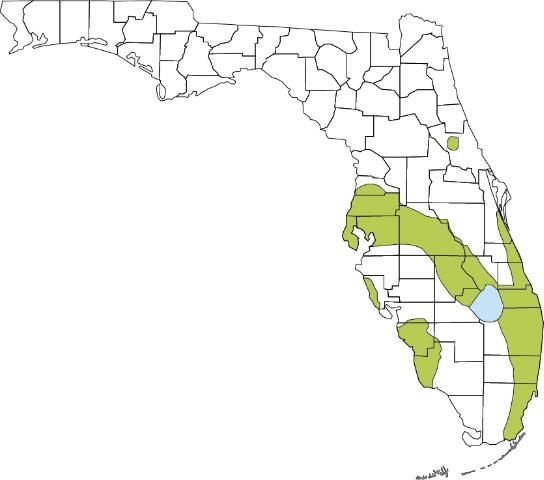
Cane toads have successfully invaded ecosystems in many parts of the world where people have intentionally introduced them. They were deliberately introduced to Hawaii, Puerto Rico, and numerous other Caribbean and Pacific islands in the 19th and 20th centuries. Cane toads are well known for their invasion of Australia, where they were introduced in the 1930s to control cane beetles, an agricultural pest. Because of their toxicity, cane toads severely affected Australian ecosystems. Death rates are high for many native Australian animals that attempt to eat cane toads (e.g., monitor lizards, freshwater crocodiles, and numerous species of snakes), and numbers of native predators have plummeted in areas where the toxic toads have invaded. Cane toads continue to expand westward across the Top End of Australia into the Kimberly region and southward toward Sydney.
In their native range, cane toads are found in greater densities in human-modified habitats than in natural settings. They are common in yards and similar open areas. Their ability to exploit habitat modified by humans is a common trait among many invasive species; cane toads have proliferated in yards, golf courses, agricultural areas, and similar habitat types in Florida. Fortunately, there are few records of cane toads in Florida's native habitats, and they do not appear to invade most natural areas in the state. Although their ecological impacts in Florida may be limited by their habitat use, they are a significant nuisance to people and are potentially lethal to pets that attack the ground-dwelling toads.
Identifying Cane Toads
Cane toads belong to the scientific family Bufonidae. Members of this family are known as "true toads," and there are four native Bufonid species in Florida. Southern toads (Anaxyrus terrestris) and oak toads (Anaxyrus quercicus) are discussed below; Fowler's toads (Anaxyrus fowleri) and Gulf Coast toads (Incilius valliceps) only occur in the western panhandle, and their range does not overlap with that of cane toads, so these two native species are not described in this document. In addition to Florida's four species of native "true toads," there is another species of native toad that shares the general features of a toad, but belongs to a different scientific family—the eastern spadefoot. Cane toads can be confused with native toads, so be sure to correctly identify the species before taking action to remove invasive cane toads from your property.
How do I know if I have found a dangerous cane toad or a harmless native toad?
First, be sure you have a toad, then read below to identify the species. Remember, all toads are frogs, but not all frogs are toads. Toads are a specific type of frog.
General Toad Features
- Live on the ground and do not climb well
- Have stout bodies with short legs
- Have slightly webbed rear feet
- Have dry, warty skin
- Have poison glands (also called parotoid glands) on shoulders
- Are mottled with various shades of gray, brown, black
Cane Toad—Invasive
- May be larger than three inches (young are smaller)
- Poison glands enlarged and somewhat triangular, tapering back to a point (Figure 2)
- No knobs or crests on top of head
- Ridge around eyes and above nose
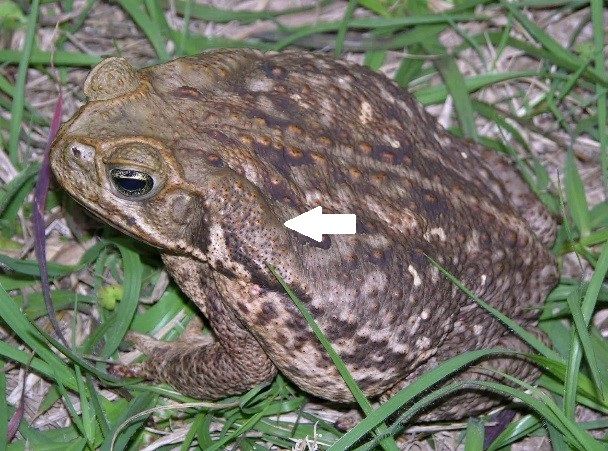
Credit: Steve A. Johnson, UF/IFAS
Adult cane toads measure between three and six inches long, and some individuals reach eight or nine inches. Males and females can be distinguished by differences in coloration and the texture of their back skin; females have smooth, mottled, brown and white backs, whereas the rough backs of males are more yellow (Figure 3). Baby cane toads recently transformed from tadpoles are the size of raisins and are easily confused with native toads.
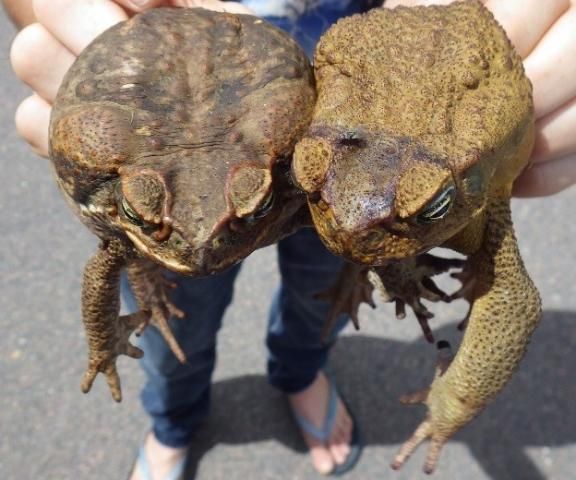
Credit: Steve A. Johnson, UF/IFAS
Southern Toad—Native
- Rarely larger than 3 inches
- Poison glands are small and oval; no danger to pets
- Two obvious crests on top of head (crests not obvious in southern toads smaller than ~1 in.)
- Gray, brown, or reddish body
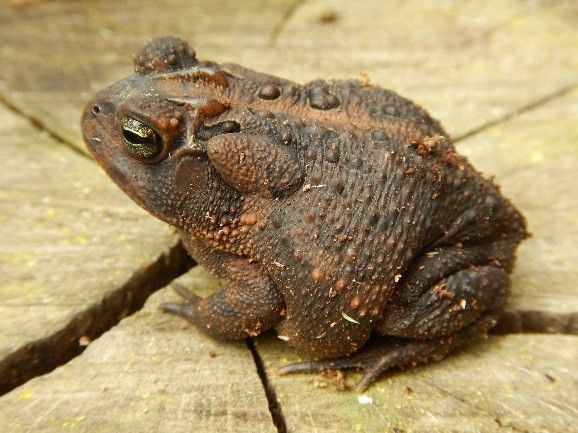
Credit: Steve A. Johnson, UF/IFAS
Oak Toad—Native
- Never larger than 1.5 inches—Florida's smallest toad
- Poison glands are small and oval; no danger to pets
- Indistinct crests on top of head
- Light-colored line down center of back
- Undersides of feet orange-colored

Credit: Steve A. Johnson, UF/IFAS
Eastern Spadefoot—Native
- Rarely larger than 2 inches
- Poison glands flattened and indistinct; no danger to pets
- No crests on top of head
- Often with hourglass shape and numerous yellow markings on back
- Prominent digging "spade" on rear feet
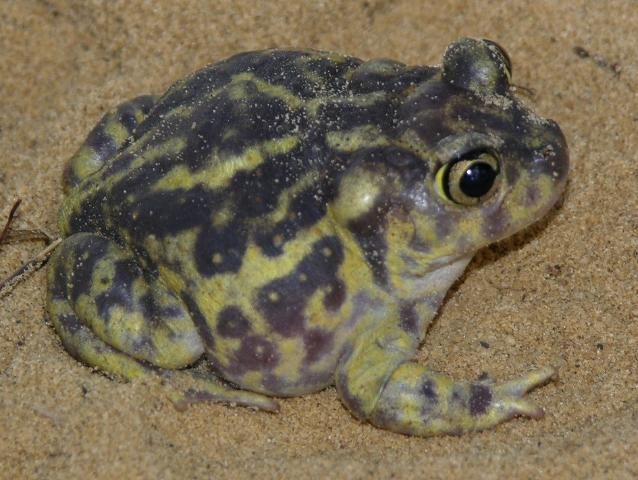
Credit: Steve A. Johnson, UF/IFAS
Watch this video to learn more about how to accurately identify toads in Florida—https://www.youtube.com/watch?v=RMzLes3BaCo&t=529s.
Cane Toad Ecology
Cane toads are highly adaptable and found in a variety of habitat types. In their native range, they live everywhere from savanna to open forest, but dense vegetation appears to act as a barrier to their movement. Where they occur in Florida, they are particularly common in yards, golf courses, school campuses, agricultural areas, and other human-modified habitats. Even in their native range, they are found in greater densities in human-modified areas than in natural habitat. Their affinity for disturbed habitat, tolerance of a wide range of conditions, and ability to adapt to new conditions are important factors enabling successful colonization in many different places. For example, cane toads thrive in acidic and saline water bodies. In Australia, cane toads have even adapted to deserts, and toads at the front of the invasion evolved longer limbs and the tendency to move in straighter lines than toads in places where they have been established longer. Longer limbs and moving in a straight line increases the speed at which they can spread Down Under.
Like most toads, cane toads are generally found in terrestrial habitats in areas with permanent water nearby. To breed, males call to attract females to a variety of water bodies including temporary pools, ponds, and canals, though they avoid swift currents. The call is a persistent, low-pitched, warbling trill, which you can listen to here: http://www.wec.ufl.edu/extension/wildlife_info/frogstoads/wav/giant_taod.wav. Calling may occur throughout the year in southern Florida but is limited to January through September further north in the state. Cane toads are incredibly prolific breeders with females depositing 8,000–30,000 eggs in long, gelatinous strings once or twice per year. Breeding usually follows heavy rain. Tadpoles hatch in about 48 hours and, depending on temperature and resource availability, require roughly two weeks to two months to develop into toadlets. Cane toads can get much larger than any of our native frogs and toads, but their toadlets are less than half an inch long—about the size of a raisin. It is very difficult to distinguish among the toadlets of the different species of toads found in Florida.
Adult cane toads are nocturnal, remaining hidden during the day and emerging only after sunset to hunt for food. However, tadpoles and younger toads are more active during the day. Research suggests this difference in activity periods helps these tiny toads avoid cannibalism from larger cane toads.
Cane toads are generalist feeders and will eat almost anything they can fit into their mouths. Beetles and ants make up the majority of their diet, but they also consume other insects and spiders, carrion, small vertebrates, garbage, and smaller members of their own species. Dog and cat food left outside for pets attracts cane toads and provides them with an easy meal.
Cane toads are poisonous throughout their life cycle. Eggs and tadpoles are even toxic and taste bad to many predators. Adults are most toxic, largely due to the amount of poison contained in the enlarged parotoid glands on their shoulders. Cane toads cannot shoot poison at will from their parotoid glands, but some individuals ooze poison when they feel threatened. However, the toxin will squirt when parotoid glands are squeezed, such as by the mouth of a predator or pet. These toxins make cane toads dangerous prey for some predators, but there are several species in Florida capable of eating them with no ill effect. American crows and red-shouldered hawks have been seen rolling the toads onto their backs, eating certain parts and avoiding toxins. Other species of birds, several types of snakes, and even Virginia opossums have been observed preying on cane toads.
Impacts on Humans and Pets
Cane toads prefer habitats created and inhabited by humans. The greatest densities of cane toads, as well as the largest individuals, are found in disturbed areas. They are particularly common in yards, golf courses, and school campuses. They eat almost anything of appropriate size and are often drawn to pet food left outside. Unfortunately, dogs and cats that attack or try to eat this highly toxic toad can be poisoned. Dogs are considerably more likely than cats to attempt to eat them, especially dogs like terriers that readily attack small animals. Severity of symptoms varies depending on the amount of toxin ingested and the size of the animal that attacked the toad, but signs of cane toad poisoning in pets include unusually pink or red gums, drooling or frothing at the mouth, pawing at the mouth, seizures, and sometimes cardiac arrest. Reports of pets, particularly dogs, falling sick or dying after attempting to eat cane toads are not uncommon in southern Florida. If you suspect your pet has eaten or attacked a cane toad, wipe its mouth out with a damp rag and use a hose to rinse its mouth for 15 minutes, making sure the water flows out of the mouth and not down the throat. And immediately contact your veterinarian!
Additional negative impacts of cane toads include toxicity to ornamental fish in outdoor ponds and potentially direct impacts on human wellbeing. Cane toad eggs and tadpoles, which are toxic, have been implicated in the deaths of koi fish in ornamental ponds. Additionally, the secretion from cane toad parotoid glands is highly irritating to human eyes and cuts on skin. Therefore, we recommend that cane toads be handled with gloves and extreme care should be taken to avoid getting toxin in eyes—wash hands thoroughly after handling a cane toad. Cane toads negatively affect human quality of life with their loud call. Dense cane toad populations in residential areas may call all night under the right conditions, potentially causing lost sleep.
Impacts on the Environment
There are few records of cane toads in natural ecosystems in Florida, though there have been calling toads detected within Biscayne and Everglades National Parks. The low number of records in natural areas suggests it is unlikely they have much of an effect in Florida's less disturbed habitats. However, native species that inhabit more urban areas may be vulnerable to the toxic toads. Cane toads are voracious predators that could potentially reduce prey availability for native species in suburban areas where cane toad densities are greatest. Whether due to competition for food, direct predation, or another factor, people have noticed that native southern toads disappear or become uncommon in their neighborhoods when cane toads arrive. Although their diet is dominated by arthropods, cane toads are also known to eat several species of small vertebrates, including native birds, snakes, and small mammals. Cane toad toxicity may put native species, particularly predators, at risk. Some native wildlife have adaptations that allow them to consume such a toxic animal, but others are vulnerable to cane toad poison. One study found that some native frogs can eat cane toad eggs, but other species were susceptible to their poison. We haven't seen the large predator die-offs that have been documented in Australia, but additional research is necessary to understand how cane toads affect native species in Florida.
Watch this video to learn more about bufo toads in Florida and how to treat a family pet that encounters a bufo toad—https://www.youtube.com/watch?v=Cg1HUuxM7Zc.
What You Can Do
There are several things you can do to reduce the impacts of cane toads in Florida and protect your pets. Hand-capture and humanely euthanize cane toads around your yard by generously applying a benzocaine or lidocaine ointment or spray to the toad's back or belly, then freeze it overnight. Several over-the-counter products containing benzocaine or lidocaine are readily available at most drug and grocery stores. They include products to treat tooth aches and skin irritations, such as sunburn. You can forgo the benzocaine treatment and simply put the cane toad in a refrigerator for a few hours to anesthetize it before transferring it to a freezer for 24 hours to ensure a humane death. Although the cool-then-freeze method has not yet been approved by the American Veterinary Medical Association as a method to euthanize amphibians such as toads, a study conducted with cane toads in Australia found it is completely humane. Use rubber gloves or a plastic grocery bag as a glove to hand-capture toads. Although a toad cannot squirt its toxin at you, it may ooze toxin and irritate skin and eyes if it is not handled carefully. Grab toads in a decisive manner—do not be timid or hesitate. An effective way to hold a captured toad is by grasping it around the waist with your thumb and index finger. Once in hand, turn the plastic bag inside-out and tie it shut to contain the toad before putting it into the fridge and then transferring it to the freezer. Because cane toads are mainly nocturnal, early evening is a good time to search your property for toads that are out and about. Use a flashlight or headlamp to help find them.
Be sure you have correctly identified the toad as an invasive cane toad before euthanizing it! Review information presented earlier in this document for identification tips. If you are still not sure if you have a cane toad or a native toad, please email Dr. Steve Johnson at tadpole@ufl.edu with a picture of the toad. He will do his best to reply to your message. Florida state statutes prohibit the release of any non-native animal in Florida without a permit, so it is against the law to catch and then release a cane toad. In other words, capturing and then releasing cane toads elsewhere is not a solution. They have the ability to home back to where they were originally captured, so taking them elsewhere and turning them loose is ineffective—most likely they will return "home." If they don't return, they may end up being a problem for someone else or create a new population in a previously uninvaded area.
To avoid attracting insects that attract cane toads, be sure to turn off outside lights around your home. If shutting off a light is not an option, using motion lights or replacing insect-attracting bulbs that emit white light with so-called "bug lights" may reduce the number of insects around your home at night. Also, do not leave bowls of pet food out at night—cane toads may learn there is a free meal at your back door. Toads may also soak in a pet's water bowl, especially during extended dry periods. Removing sources of water/moisture on your property will help make your yard less attractive to cane toads—and mosquitos! Remove any cane toad eggs (laid in long strings) and tadpoles (small and solid black in color) from ornamental ponds or pools that are not well chlorinated. Another way to make your yard less suitable for cane toads is to remove debris piles where toads may seek shelter during the day. Block access to compost heaps and other hiding places, such as under A/C units or decks and around the edges of buildings.
To avoid potentially deadly consequences, do not leave dogs unattended outdoors at dawn, dusk, or at night when cane toads are most active. When walking pets in the evening or at night in areas that cane toads frequent, be sure to keep your dog on a short leash. Dogs with a strong prey drive may attack a toad. If you are unable or not willing to remove cane toads from your property but want them gone, you may be able to have a nuisance wildlife trapper do the dirty work for you. However, they do not work for free and their fees for animal removal can be expensive, so get details before hiring someone. To search for a nuisance wildlife trapper in your area visit: https://app.myfwc.com/HGM/NWT/NWTSearch.aspx.
Watch this video to learn how to capture and humanely euthanize invasive bufo toads on your property—https://www.youtube.com/watch?v=JCZlSVbOkWU.
Reporting Cane Toads
If you encounter a cane toad within the area that they are known to inhabit (Figure 1), please report your sighting on the Early Detection & Distribution Mapping System, (EDDMapS). You will need a digital image of the toad and its specific location. The first time you report a toad in EDDMapS, you will be required to create an account, which only takes a few minutes. You can access EDDMapS at https://www.eddmaps.org/report/ and download the "IveGot1" app for your smartphone to make reporting cane toad sightings more convenient.
If you find a cane toad outside their current range (Figure 1), please contact Dr. Steve Johnson of the University of Florida at tadpole@ufl.edu. Please include a picture of the toad as well as the county and address where you found it. Once you have reported the observation to Dr. Johnson, please document it at the EDDMapS site as described above.
Additional Sources of Information
Dr. Steve Johnson's UF Wildlife website has an online guide to Florida's frogs (click link in left column). Be sure to check out the species accounts for cane toads and southern toads. https://ufwildlife.ifas.ufl.edu/index.shtml
The Florida Fish and Wildlife Conservation Commission maintains a page devoted to cane toads that you can find here: https://myfwc.com/wildlifehabitats/profiles/amphibians/cane-toad/
National Geographic has a site with cane toad images and a brief summary about their invasion of Australia. https://www.nationalgeographic.com/animals/amphibians/facts/cane-toad
For more information about cane toads in Australia, please visit the Australian Museum's web page https://australian.museum/learn/animals/frogs/cane-toad/, or Dr. Rick Shine's website https://www.canetoadsinoz.com